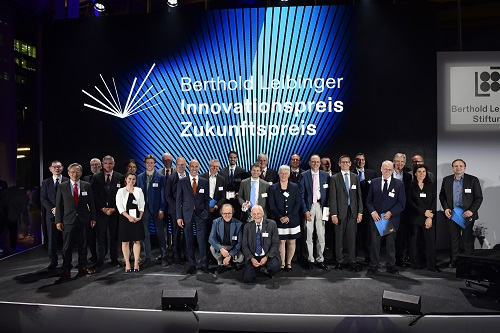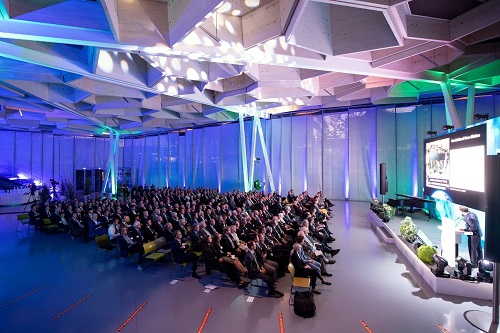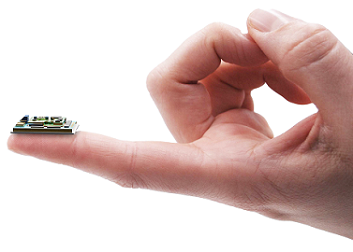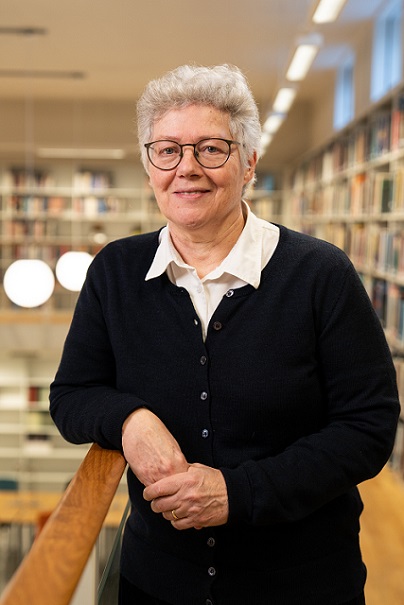The Berthold Leibinger Foundation highlights the most cutting-edge advancements in laser technology, with three Innovationspreise (Innovation Awards) and its prestigious Zukunftspreis (Future Award).
ANDREAS THOSS, CONTRIBUTING EDITOR
In 2000, Berthold Leibinger, the man who brought laser technology into Germany’s TRUMPF Group, established the Innovation Award — expressed in native German as the “Innovationspreis” — to honor outstanding R&D in the field of laser technology. Next to this prestigious award, the Berthold Leibinger Zukunftspreis was added in 2006 to recognize scientists driving fundamental laser research to new heights.
Leibinger sadly passed away a few weeks after the Innovationspreis ceremony in 2018, but he had handed the company over to his children years before, along with the Berthold Leibinger Foundation and its associated awards.
At the 2023 ceremony, held on September 22 in Ditzingen, the Foundation issued three awards for innovation and one for basic research before an unforgettable gathering that united the laser community to celebrate both recognition and collaboration.

The 2023 Berthold Leibinger Awards ceremony was held Sept. 22 in Ditzingen, Germany. The Berthold Leibinger Foundation and esteemed guests celebrated four award winners.
The next award ceremony will not convene again until June 20, 2025, on the Friday before the next LASER World of PHOTONICS event launches in Munich.
Pushing interferometry’s limits
One of the most exciting scientific advancements of the last decade was certainly the measurement of gravitational waves. One hundred years after Albert Einstein predicted the existence of this effect in 1916, scientists from the LIGO collaboration reported the first successful measurement of a gravitational wave — a discovery deemed so important that it earned the Nobel Prize just one year later.
The device that enabled this measurement has a fine piece of laser technology in its core; a laser interferometer that detects changes in the length of its arms down to 1/10,000 of the diameter of a proton. That is a level of precision that is beyond even the imagination of the laser experts attending this year’s award ceremony in Ditzingen, which helps explain why the laser interferometer’s development team was awarded one of this year’s three Berthold Leibinger Innovationspreise. They are now pushing the boundaries of the instrument’s precision even further.
Researchers Hartmut Grote of Cardiff University, Wales, and Henning Vahlbruch and Benno Willke, both from the Max Planck Institute for Gravitational Physics (Albert Einstein Institute), in Hannover, Germany, developed three essential innovations for the LIGO interferometer: extreme stabilization of the instrument’s high-power lasers, generation and coherent control of squeezed vacuum fields, and novel control techniques for the application of squeezed light.
These complex technologies have been described previously in scientific publications. But there is one detail of particular technological beauty that should be mentioned here: the use of squeezed light to reduce the phase noise in the interferometer.
To understand squeezed light, one has to look at Heisenberg’s uncertainty principle, which says that, in the quantum realm, you cannot measure both momentum and position with total precision. In fact, the product of the uncertainty of both quantities is constant. This holds for the phase and the amplitude of laser light, as well. Thus, one can create light where the uncertainty of the phase measurement is much smaller than the uncertainty of the amplitude — in other words, the uncertainty product is “squeezed.”

A squeezed light source at Cardiff University is used to push the detection limits in dark matter research. Courtesy of Hartmut Grote.
Raising the level at which light is squeezed in the interferometer within the gravitational wave detector could increase the observational volume up to a factor of 30 more gravitational wave detections in the future.
The development of cutting-edge laser technology in the context of gravitational wave research has already triggered many other developments, including a laser company that is turning these ideas into products.
But the innovators honored in Ditzingen also see new prospects on the research side: "We are doing experiments to find dark matter with squeezed light," said Hartmut Grote, by way of example. Another potential application field could be quantum communication, for which squeezed light would help facilitate the shift from discrete variable quantum information to continuous variable quantum communication. This would significantly improve transmission rates.

IR spectroscopy on a fingertip
It is rare for the work of a doctoral student to lead to the founding of a company. Jan Kischkat was one such doctoral student who faced a problem in his research, worked through the science case, found the right partners and, with them, developed the components to build a commercial product. Another of this year’s three Berthold Leibinger Innovationspreise was awarded to him and the team from Quantune Technologies in Berlin for the development of a tunable external-cavity quantum cascade laser.
The challenge Kischkat addressed in his Ph.D. research was the inverse correlation between the size of IR spectrometers and their applicability. There are many applications for these devices because the so-called fingerprint region for most organic molecules is between 3 and 15 µm, where these sources emit. Kischkat estimated that 50,000 of these devices were sold annually — a number, he further calculated, that could be larger if the instruments were not typically bigger than an old-fashioned personal computer.
It took ten years and a number of significant innovations for Kischkat and his team to shrink an IR spectrometer to the size of a fingertip. One key innovation was the light source for this: the newly developed quantum cascade lasers from Quantune Technologies.

After ten years of research and development, the first IR spectrometer no larger than a fingertip comes to the market. Courtesy of Quantune Technologies.
Another innovation was the way in which the system tuned the laser’s wavelength. Regular spectrometers use gratings, which need a considerable laser spot size to achieve diffraction. Quantune replaced the grating with a tunable etalon, followed by a retroreflector. This approach opened the road for a micro-optical integrated solution.
None of the required components existed as off-the-shelf products at the time. So, the team partnered with a range of research institutions that each offered unique capabilities to develop the components that were needed to turn the vision into a product. Their work was successful and the miniaturized spectrometer is entering into the market in two versions: one as a general-purpose spectrometer module, and the other as a medical technology platform that will measure biomarkers through skin tissue.
Listening to the heartbeat
A stethoscope is a medical instrument familiar to anyone who has felt one pressed to their chest as part of a routine medical examination. Now imagine a contactless stethoscope that employs a laser beam to measure the heartbeat with digital precision. That is essentially what earned researchers Zeev Zalevsky of Bar-Ilan University in Israel and Javier Garcia from the Universitat de València in Spain their Berthold Leibinger Innovationspreis. But their vision goes far beyond this application.
Their basic idea exploits laser speckles, which become visible as a random pattern when a laser beam shines on a rough surface. Often, information is drawn from the contrast of speckles within such a pattern. Zalevsky and Garcia went a different way. They used the spatial characteristics of the backscattered speckles to provide information about nano-vibrations on the surface of a patient’s skin or blood vessels. A camera with special optics and a machine learning algorithm then enables measurement of these tiny movements.

This prototype for a contactless optical stethoscope has been approved by the FDA. Courtesy of Zeev Zalevsky.
This concept has been used to sense vital signs such as heart rhythm, respiration, or blood pulse pressure. After appropriate clinical tests, a device based on this concept has already received FDA approval for sensing specific vital signs.
The speckle pattern is effectively used to “listen” to the body, so the idea can be expanded with a microscopic loudspeaker. For example, the speckle signal can be used to measure changes in the intra-ocular pressure with its micro noise. Neither the laser nor the acoustic signal require physical contact with the eye to gather information. The method has also been tested for the measurement of blood constituents, such as glucose or alcohol.
One future vision for the research is literally mind blowing: IR light can be sent through active brain tissue and Zalevsky and Garcia's speckle imaging method would allow it to identify active areas in the brain in real time. Based on this, the scientists are working on a method to find areas in the brain that are undergoing a stroke. A physician would then be able to identify and locate the aneurysm within moments of a patient's admission to the emergency room. Although this application is still a remote vision, the researchers have already achieved close to 1-mm-resolutions in brain images.
And the Zukunftspreis goes to …
It is a core motivation of scientific research that people see a physical limitation and start to think about how the obstacle can be overcome. The duration of a single-cycle laser pulse is one such limit. In the visible region, such a pulse is a few femtoseconds long. How could one possibly make a flashlight that is shorter than this shortest possible flash?
Anne L’Huillier from Lund University, Sweden, received the prestigious 2023 Berthold Leibinger Zukunftspreis for her groundbreaking work in the field of attosecond physics, a field of science that explores ways to generate, measure, and use light pulses that are much shorter than 1 fs.
Within 100 attoseconds, light moves only 30 nm, which is less than the tenth part of blue light’s wavelength. Attoseconds are the timescale in which an electron’s movement occurs in an atom. An attosecond flash allows the study of the dynamics of the electron as it gets excited and leaves the atom.

Anne L’Huillier from Lund University, Sweden, was awarded the 2023 Berthold Leibinger Zukunftspreis for her groundbreaking research in the field of attoscience. Courtesy of BBVA Foundation.
Anne L’Huillier laid the foundations for this field when she, together with her colleagues at the Commissariat à l’Energie Atomique, in Saclay, France, discovered that atoms exposed to short intense IR laser pulses emit harmonics (i.e., overtones) of the laser light up to a very high order. These pulses with a wavelength much shorter than visible laser light turned out to be the entry point to the world of attophysics. It took more than a decade until the first isolated attosecond pulse was generated in an experiment led by Ferenc Krausz. After another 20 years, “this field of research is exploding in every direction,” as L'Huillier says. Be it for chemistry or quantum information science, L’Huillier’s work has enabled a generation of researchers to push yet another boundary that seemed impossible to overcome.